Kutz M. Handbook of materials selection
Подождите немного. Документ загружается.

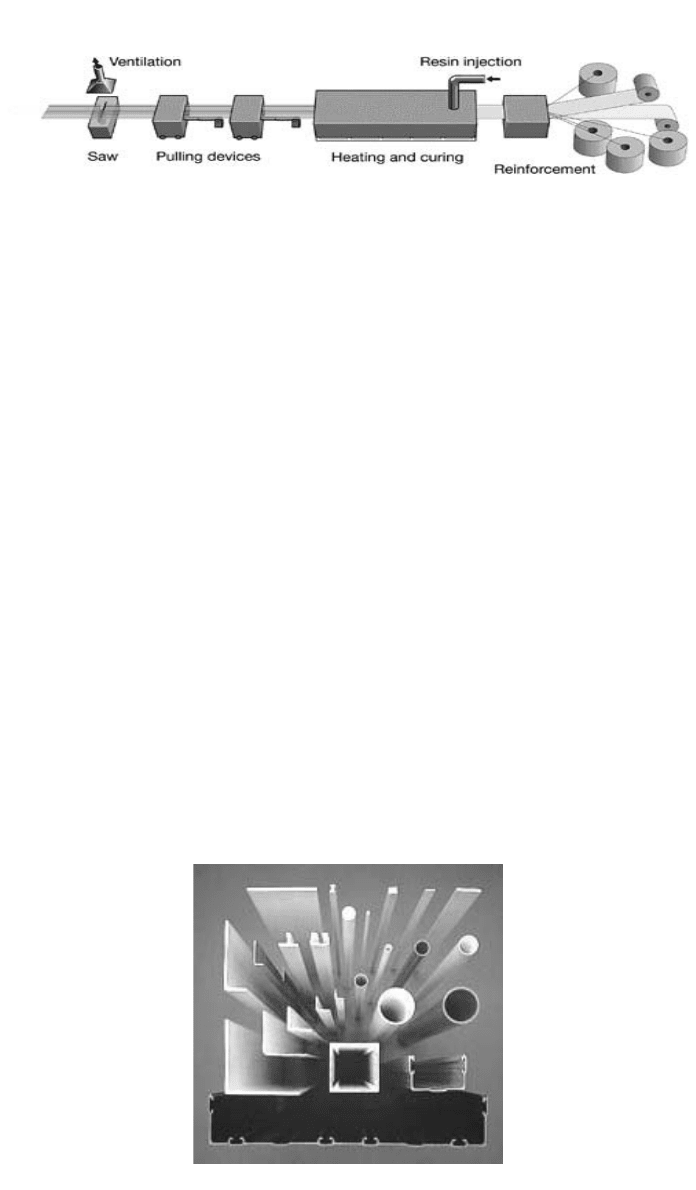
1402 COMPOSITES IN CONSTRUCTION
Fig. 36 Pultrusion process. (Courtesy of Fiberline Composites A / S)
Fig. 37 Sample of pultruded composites profiles. (Courtesy of Fiberline Composites A / S)
common fiber type is the E-glass in the form of rovings and strand mats. How-
ever, recently, carbon/E-glass composite profiles have been produced in limited
bridge applications.
As shown in Fig. 37, with few exceptions, the majority of the off-the-shelf
pultruded profiles is similar, in geometry, to steel profiles and are commercially
available in different sizes and grades [Fiberline (2000), Bedford (1999), Crea-
tive Pultrusions (1985), Strongwell (1990)].
Although the use of unidirectional reinforcement schedule may be satisfactory
for lightweight or secondary structural members, it indeed is not sufficient for
primary structural carrying members such as bridge decks, girders, and columns.
Other disadvantages of using thin-walled unidirectional ‘‘steel-like’’ PFRP pro-
files include the insufficient lateral and buckling resistance of the section. In
addition, in the majority of commercially produced unidirectional open web
(e.g., H-profile, channels, angles, etc.) and closed-web (e.g. rectangular and box
profiles) there is a lack of fiber continuity between the web(s) and flanges. For
this reason a premature failure at the web–flange junction is the common mode
of failure of such profiles. A comprehensive discussion on this issue is reported
by Mosallam (1993, 1996).
Research and Development of PFRP Composite Structures
In the late 1980s, several major research projects were initiated to study the
structural performance of pultruded composite structures. In 1990, Mosallam
conducted a comprehensive study on the behavior of PFRP portal frame. The
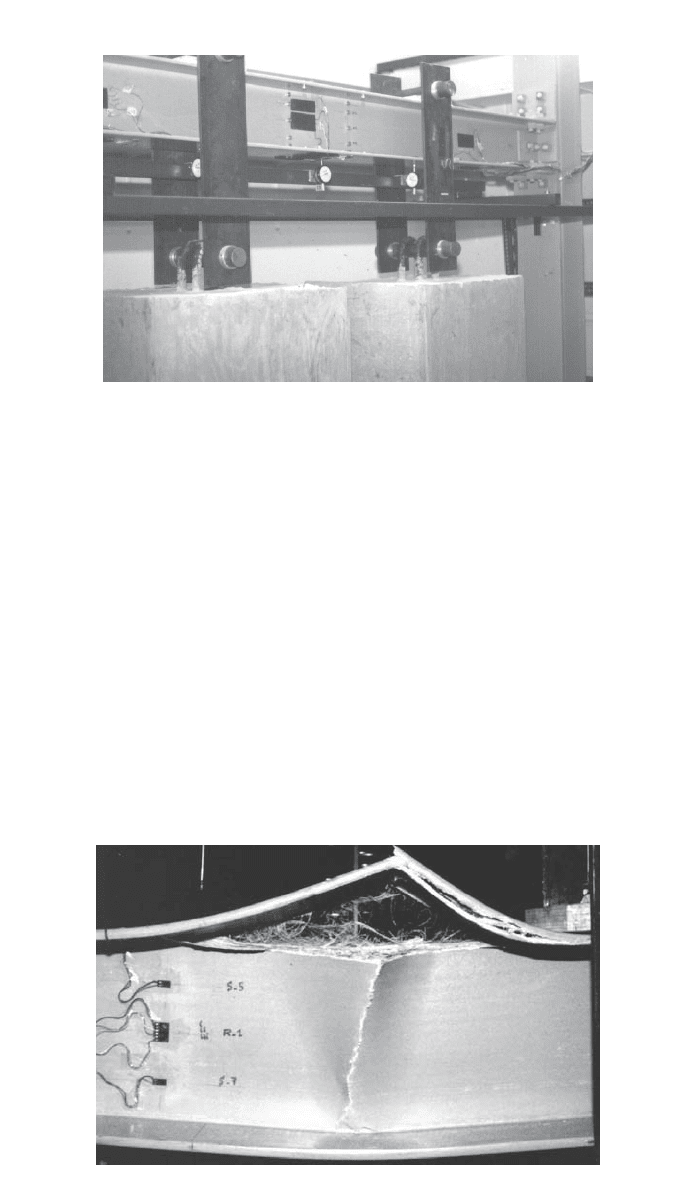
2 CONSTRUCTION APPLICATIONS OF COMPOSITES 1403
Fig. 38 10,000-h full-scale creep test of a PFRP composite portal frame (Mosallam, 1990).
Fig. 39 Failure of web/ flange junction of PFRP open-web profiles (Mosallam, 1990).
study included both full-scale experimental testing and theoretical modeling. The
experimental part focused at the creep behavior (Fig. 38), service and ultimate
behavior, framing connections, and buckling and postbuckling performance of
PFRP frames. Simple expressions for the viscoelastic moduli (axial and shear)
of the PFRP composites were developed. The ultimate mode of failure and the
effect of the nonlinearity of the framing joints on the stiffness and buckling
behavior of the pultruded thin-walled sections were also performed (Bank and
Mosallam, 1992). Based on the test results (Mosallam, 1990), a premature local
failure of open-web unidirectional PFRP sections occurred due to the inadequacy
of reinforcement continuity at the web–flange junction (Fig. 39). This premature
failure caused by the separation of the web and the flanges of the open-web
PFRP elements at the stress concentration locations (usually at the connections
and the girder midspan) affects the general behavior of the structure. For ex-
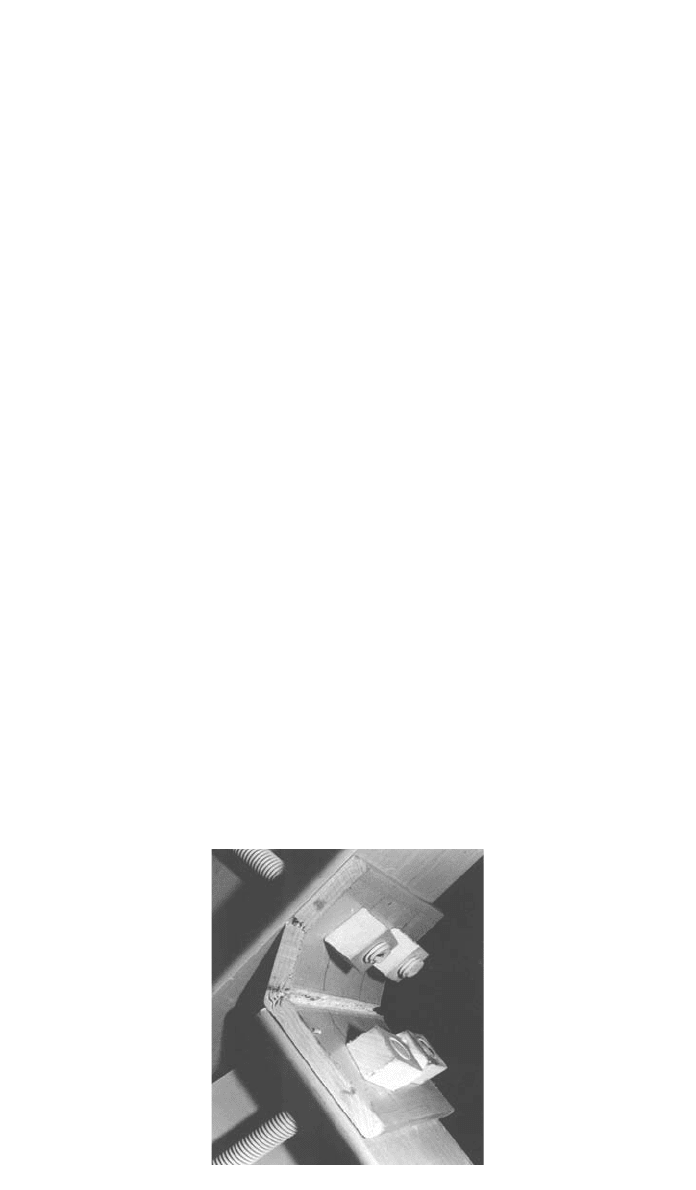
1404 COMPOSITES IN CONSTRUCTION
Fig. 40 Premature failure of steellike connection details (Mosallam, 1993).
ample, results of experimental and theoretical research work (Mosallam, 1993;
Mosallam et al., 1993) showed the direct effect of this premature failure of the
column section of frame structures in the rotational stiffness PFRP frame con-
nections during the crack growth up to the failure. The loss of the flexural
stiffness results in a decrease of the connection rotational capacity, and conse-
quently an increase in the flexural stresses at the girder midspan of a PFRP
frame structure. Simple reinforcement techniques for overcoming this pre-mature
failure were reported by Mosallam (1996).
Unlike aerospace-type joints where the majority of applications is concerned
with lap splice joints, the majority of composite joints used in construction
applications involve frame connections.
For any frame structure, connections are considered to be of the most critical
structural elements, which play a major role in controlling both the serviceability
and ultimate strength of the PFRP frame structures. Careful design of the con-
necting elements will ensure both the safety and the efficient use of the material.
Previous studies on PFRP frame structures (Mosallam, 1990; Bank et al., 1990)
showed that a premature failure of pultruded shapes would occur if a wrong
connection details were used (refer to Fig. 40). Based on this fact, Bank et al.
(1992) have extended this work by introducing different connection details to
overcome the premature failure of the pultruded shapes at the web–flange junc-
tion of PFRP H-beams. The connection details presented in their study consid-
ered the anisotropic properties of the PFRP structures. Their results showed that
maximum strength and maximum stiffness could be achieved by using a con-
nection with both mechanical and adhesive elements.
All PFRP connections developed and tested in all previous studies (e.g., Bank
et al., 1992) have utilized PFRP connecting elements, which were commercially
produced and were not intended specifically for connecting purposes. This was
an appropriate approach to demonstrate the deficiency of the existing connection
details, as well as to provide strengthening details for reinforcing the existing
PFRP connections. To overcome this problem, a different approach for con-
necting PFRP structural elements to ensure the prosperity and the efficient and
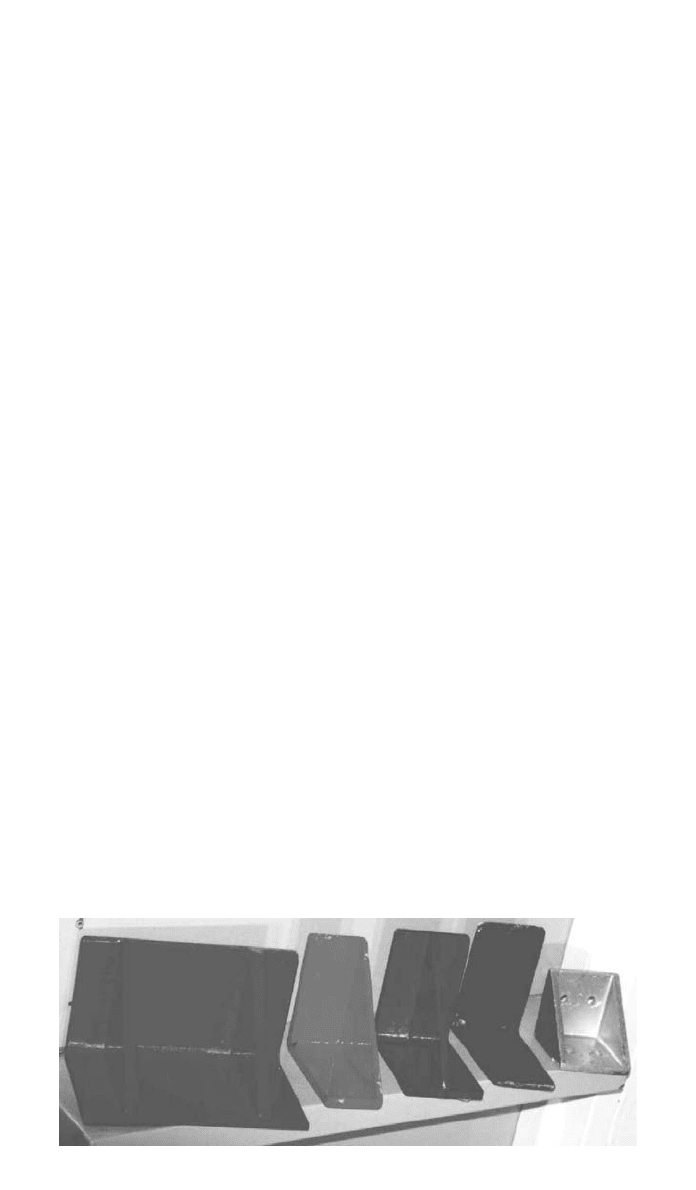
2 CONSTRUCTION APPLICATIONS OF COMPOSITES 1405
Fig. 41 FRP composite continuous universal connectors for PFRP framing joints.
(Courtesy of Sigma Composites, LLC)
safe use of this material should be used. This approach is to develop a special
connecting element or system using a mixture of past experience, available re-
search and design data, and knowledge of the anisotropic behavior of the com-
posite materials. The design criteria of the connecting elements include proper
fiber orientation, ease of erection and duplication, geometrical flexibility of the
use for different structural connections, and maximizing both the overall con-
nection stiffness and ultimate capacity. Based on these criteria, a custom-made
FRP prototype connector was developed and was fabricated [using resin transfer
molding (RTM)] from E-glass/vinylester composition. This FRP-connecting el-
ement [designated, herein, as the universal connector (UC)] was developed by
Mosallam (1993). The UC element can be used for the majority of PFRP con-
nection details for joining different structural shapes, e.g., exterior and interior
beam-to-column connection, column–base connections, continuous beam con-
nections, beam-to-girder connections, and others (Fig. 41). An extensive theo-
retical and experimental program on the development and characterization of
PFRP connections is in progress.
The dynamic response of both PFRP materials and structures was investigated
by Mosallam et al. (1993). In this study, results of experimental dynamic tests
of FRP pultruded structural elements and framed structures were presented. The
thin-walled elements used in this study were standard ‘‘off-the-shelf’’ pultruded
4 in. (101.6 mm)
⫻ 4 in. (101.6 mm) ⫻ in. (6.35 mm) H-beam and 2 in. (50.8
1
–
4
mm) ⫻ 2 in. (50.8 mm) ⫻ in. (6.35 mm) square tube made of E-glass–
1
–
4
polyester composition. All the connectors and connection elements were made
of PFRP threaded rods, nuts, and high-strength epoxy adhesive. The test speci-
mens in this study were excited dynamically using both impact loading and
shaking loads. Experimental modal analysis was used to extract the natural fre-
quencies, modal damping, and mode shapes of the test specimens. Comparison
between two types of frame connections was also performed to determine the
effect of using high-strength adhesives. The study further showed the validity of
using both the material properties and the lay-up of the coupons in modeling
PFRP beams and frame structures.
A pilot study on evaluating the structural cyclic performance of composite
frame connections for pultruded structural systems was conducted by Mosallam
(1999). In this study, several full-scale cyclic tests were conducted on several
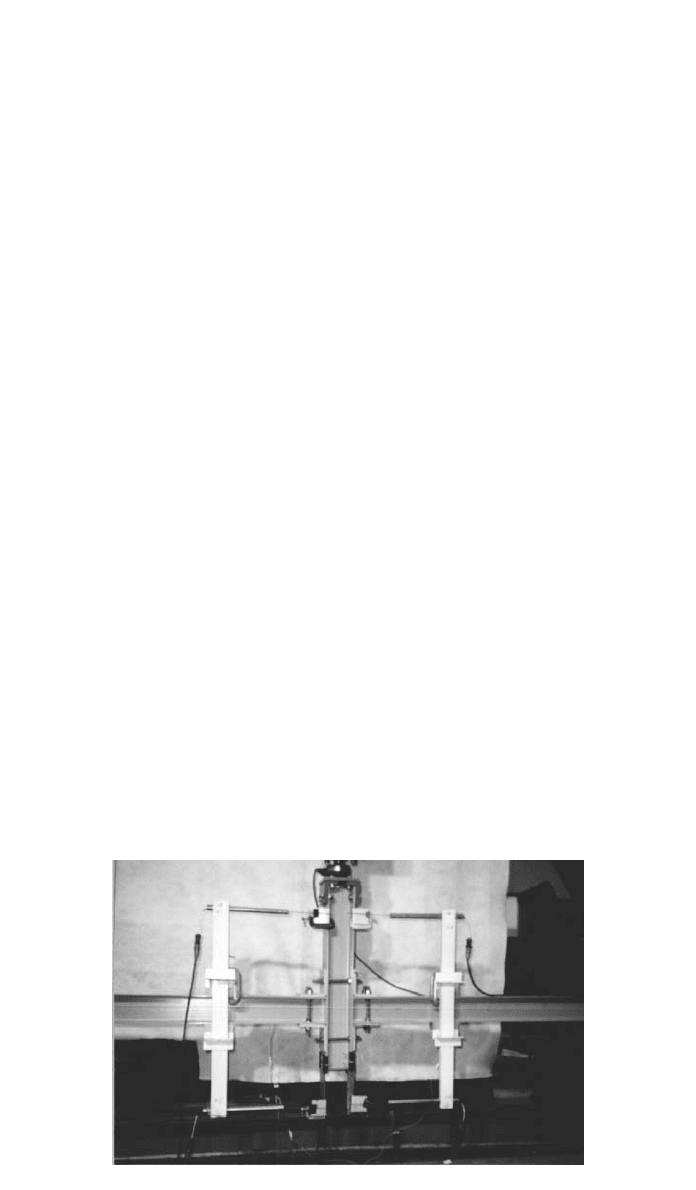
1406 COMPOSITES IN CONSTRUCTION
Fig. 42 Cyclic behavior of PFRP composite frame joints (Mosallam, 1999).
pultruded framing elements (Fig. 42). This included box and H-beam profiles
with different sizes. The emphasis of this study was on interior framing con-
nections with both flange and web attachments. In addition to high-strength
adhesives, both FRP and steel mechanical fasteners were studied. Bolted-only,
adhesively bonded only, and combined joint details were evaluated using both
metallic and nonmetallic bolts. Strain, deflection, and load information were
collected using a computerized data acquisition system. Hysteresis curves M/
and P/
␦
were developed and analyzed (Fig. 43). For FRP mechanical fasteners
bolted-only connections, a common mode of failure was observed for all spec-
imens. This was a combination of bolt thread shaving and flexural fatigue-type
failure of pultruded threaded rods. Other local failures to the pultruded thin-
walled beam sections were observed at the ultimate moment. Delamination co-
hesive failures were also observed for adhesively bonded connection details.
Currently, a pilot experimental program has been initiated by the author on
the seismic behavior of PFRP three-dimensional frame structures (Fig. 44). In
this program, both one- and two-story three-dimensional frames made entirely
from PFRP composites and gratings are evaluated under ground motion. The
tests focus on evaluating the effect of different connection details on the dynamic
response of the PFRP frame structure.
Construction Applications of PFRP Composites
Buildings Applications. Several projects have been constructed entirely us-
ing pultruded fiber-reinforced polymer (PFRP) composite sections as the main
structural elements. One of the early applications is the construction of four
PFRP turret towers on top of the Sun Bank Building, Orlando, Florida. Figure
45 shows the framing of one of the three-story high towers, which was built
entirely from PFRP shapes (H, angles, threaded rods, and nuts). All columns
and girders were constructed using open-web H sections, which were connected
together using FRP bolts and nuts. The use of PFRP composites was the pre-
ferred choice because of the electromagnetic transparency and radio wave re-
flection properties of composites. Due to the nonmagnetic properties of PFRP
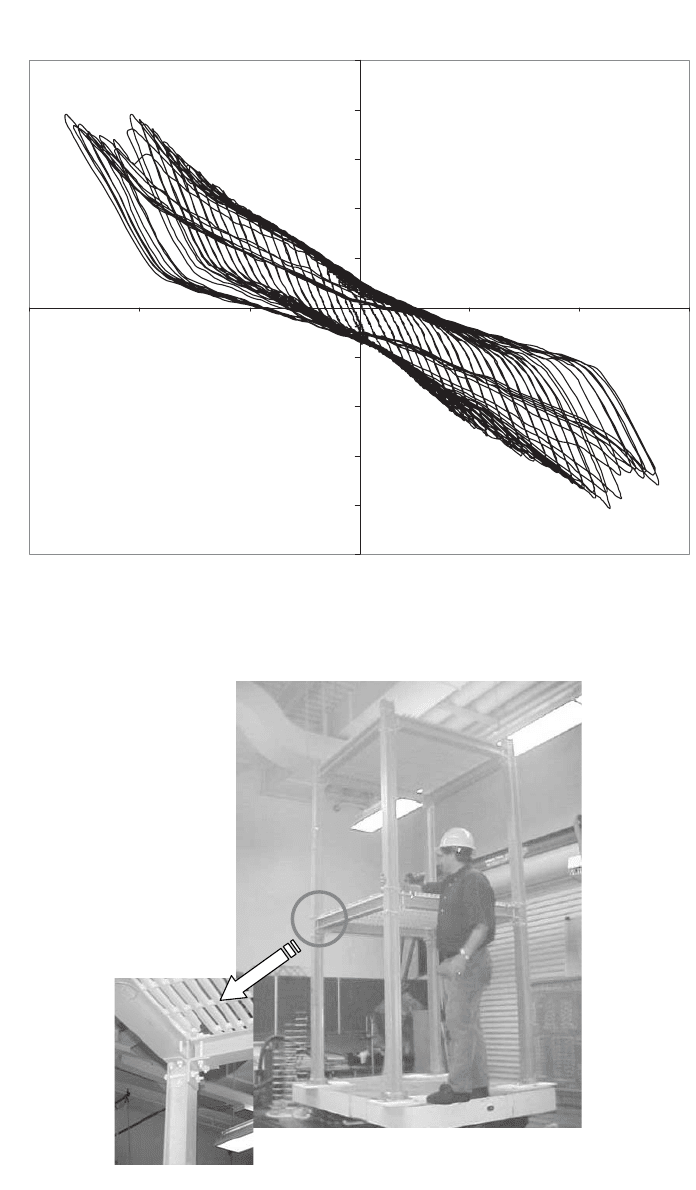
2 CONSTRUCTION APPLICATIONS OF COMPOSITES 1407
-25
-20
-15
-10
-5
0
5
10
15
20
25
-0.06 -0.04 -0.02 0 0.02 0.04 0.06
Rotation (rad)
Moments (kips-inch)
Fig. 43 Typical M / ⌰ hysteresis of PFRP composite frame joint (Mosallam, 1999).
Fig. 44 Seismic evaluation of three-dimensional PFRP frame structure with PFRP gratings.

1408 COMPOSITES IN CONSTRUCTION
Fig. 45 Three-story high towers framing of the Sun Bank Building, Orlando, Florida.
(Courtesy of Strongwell Company)
composites, it is commonly used for facilities with delicate instrumentation. Fig-
ures 42 and 44 show a complete frame structure, which was constructed using
PFRP materials. The ease of fabrication, transportation, and erection resulted in
shorter construction time.
The first residential/office building with PFRP structural profiles was pre-
sented as the Eyecatcher Project at the Swissbau’99 Fair in Basel, Switzerland.
After the exhibition, the construction was disassembled and brought to its new
location at Mu¨nchensteinerstrasse 210, Basel, where it now serves as a perma-
nent office building. The Eyecatcher all-composite building is open to the public
on agreement. The height of the all-composite 5-story building is 15 m (49.21
ft) (with a ground-floor area of 10
⫻ 12 m (30.48 ⫻ 39.37 ft). The inclined and
vertical columns were fabricated as a buildup section made of one H-profile and
two U-profiles. The horizontal frame girders were also built-up sections made
of two U-profiles and four flat pultruded plates. In all builtup sections, the pul-
truded composite profiles were bonded using high-strength epoxy and were sub-
sequently bolted together with steel bolts. Figure 46 shows the skeletons during
construction and the finished office building. Other examples of composite fram-
ing structures are shown in Figs. 47 and 48.
Bridge Applications. In the United States, there are over 90,000 weight-
restricted bridges. In most cases, there are no funds allocated to solve the prob-
lem by replacing these decks. These bridges are frequently replaced with a
modern multigirder design to restore the route to traffic without weight restric-
tions. To replace the bridge would have cost $2.4 million. In the past few years,
FRP composite decks have proven to be an ideal solution to this problem, with
a cost reduction of up to 30% as well as the tremendous saving in construction
time and traffic interruption.
In the past few years, the U.S. Department to Transportation (DOT) has util-
ized composite decks to replace corroded and underrated bridge decks. For ex-

2 CONSTRUCTION APPLICATIONS OF COMPOSITES 1409
Fig. 46 All-composite ⴖEyecatcherⴖ building in Switzerland: (a) pultruded frame skeletons and
(b) the completed structure. (Courtesy of Fiberline Composites A/ S)
Fig. 47 Pultruded composites frame structure. (Courtesy of Strongwell Company)

1410 COMPOSITES IN CONSTRUCTION
Fig. 48 All-composites skeleton. (Courtesy of Strongwell Company)
ample, the New York DOT has selected the composite deck solution to replace
the old deck of the Chemung County Bridge. This steel truss bridge was origi-
nally built in 1940, with a span length of 140 ft (42.7 m) and a width 24 ft
(7.32 m). The average daily traffic on this bridge (AADT) is 3250 and 7% of
this volume is trucks. There were several factors contributing to the posting
problem of this bridge, which is typical of the majority of old steel bridges,
including:
●
Over the past 60 years, little more than a new course of asphalt every few
years was added to smooth the wearing surface. This resulted in an in-
crease of dead load.
●
In addition, some steel sections were rusted.
●
In the original design, the bridge was never intended to carry the heavy
loads on the road today.
The engineers in New York DOT Region 6 decided to adopt the FRP com-
posite lightweight solution (refer to Fig. (49), in addition to repairing and paint-
ing the steel truss members. After the addition of the FRP bridge deck, the load
rating of the bridge raises from the original inventory of HS12 (22 tons) with
operating capacity of HS18 (33 tons) to an inventory of HS23 (42 tons) with
operating capacity of HS34 (61 tons). Figures 50 and 51 show the FRP bridge
deck during fabrication and installation, respectively.
Another major highway bridge project that utilized FRP composite decks is
the Salem Avenue Bridge located just west of downtown Dayton, Ohio. Four
different FRP composite decks were used.
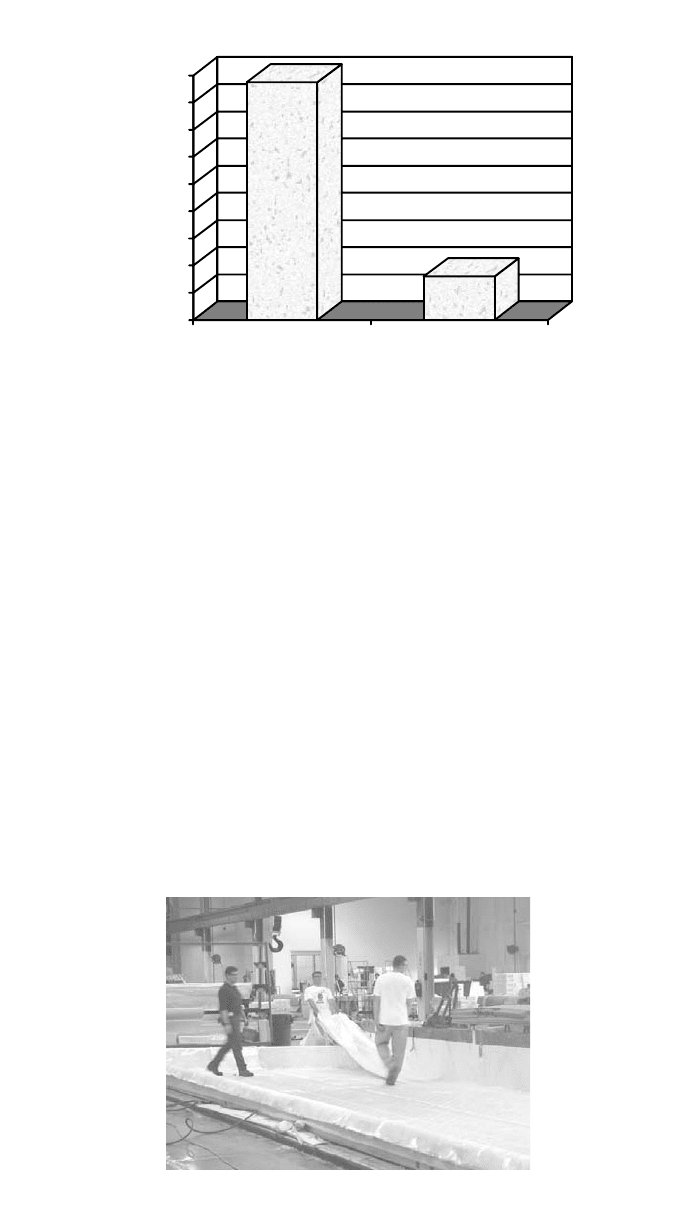
2 CONSTRUCTION APPLICATIONS OF COMPOSITES 1411
0
20
40
60
80
100
120
140
160
180
Self Weight (psf)
Existing deck FRP Composite
Fig. 49 Self-weight comparison between existing and new FRP composite deck of the
Bentley Creek, Chemung County, New York.
Fig. 50 Fabrication of the FRP composite bridge deck of NY 367 over Bentley Creek,
Chemung County, New York. (Courtesy of New York DOT, Region 6, Hornell, NY)
1. CDS Deck. Consists of FRP stay-in-place forms that act as bottom rein-
forcement for the composite/FRP hybrid deck. The top layer of reinforcement
consists of GFRP rebars. The composite forms were filled with high-strength
concrete.
2. CPI Deck. Consists of pultruded interlocking profiles that run transverse
to the bridge centerline and are adhesively bonded at the shop to form 8-ft-wide
(2.43-m) composite panels (refer to Fig. 52). The panels were attached to the
existing steel girders using Nelson shear studs that were welded to the top of
the steel girders.
3. HCI Deck. Coinsists of a sandwich panel with high-density foam core
that were manufactured using Seemman Composite Resin Infusion Molding Pro-
cess (SCRIMP). The composite panels were connected to the steel girders using
Nelson studs.
4. ICI Deck. Consists of deep sandwich panels with prefabricated corrugated
and straight E-glass composite shells bonded together. Same connectors were
used.
